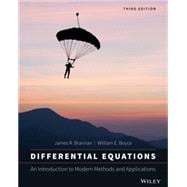
Note: Supplemental materials are not guaranteed with Rental or Used book purchases.
Purchase Benefits
What is included with this book?
James R. Brannan is the author of Differential Equations: An Introduction to Modern Methods and Applications, 3rd Edition, published by Wiley. William E. Boyce is the author of Differential Equations: An Introduction to Modern Methods and Applications, 3rd Edition, published by Wiley.
Chapter 1 Introduction 1
1.1 Mathematical Models and Solutions 2
1.2 Qualitative Methods: Phase Lines and Direction Fields 12
1.3 Definitions, Classification, and Terminology 28
Chapter 2 First Order Differential Equations 37
2.1 Separable Equations 38
2.2 Linear Equations: Method of Integrating Factors 45
2.3 Modeling with First Order Equations 55
2.4 Differences Between Linear and Nonlinear Equations 70
2.5 Autonomous Equations and Population Dynamics 80
2.6 Exact Equations and Integrating Factors 93
2.7 Substitution Methods 101
Projects
2.P.1 Harvesting a Renewable Resource 110
2.P.2 A Mathematical Model of a Groundwater Contaminant Source 111
2.P.3 Monte Carlo Option Pricing: Pricing Financial Options by Flipping a Coin 113
Chapter 3 Systems of Two First Order Equations 116
3.1 Systems of Two Linear Algebraic Equations 117
3.2 Systems of Two First Order Linear Differential Equations 129
3.3 Homogeneous Linear Systems with Constant Coefficients 145
3.4 Complex Eigenvalues 167
3.5 Repeated Eigenvalues 178
3.6 A Brief Introduction to Nonlinear Systems 189
Projects
3.P.1 Estimating Rate Constants for an Open Two-Compartment Model 199
3.P.2 A Blood–Brain Pharmacokinetic Model 201
Chapter 4 Second Order Linear Equations 203
4.1 Definitions and Examples 203
4.2 Theory of Second Order Linear Homogeneous Equations 216
4.3 Linear Homogeneous Equations with Constant Coefficients 228
4.4 Mechanical and Electrical Vibrations 241
4.5 Nonhomogeneous Equations; Method of Undetermined Coefficients 252
4.6 Forced Vibrations, Frequency Response, and Resonance 261
4.7 Variation of Parameters 274
Projects
4.P.1 A Vibration Insulation Problem 285
4.P.2 Linearization of a Nonlinear Mechanical System 286
4.P.3 A Spring-Mass Event Problem 288
4.P.4 Euler–Lagrange Equations 289
Chapter 5 The Laplace Transform 294
5.1 Definition of the Laplace Transform 295
5.2 Properties of the Laplace Transform 304
5.3 The Inverse Laplace Transform 311
5.4 Solving Differential Equations with Laplace Transforms 320
5.5 Discontinuous Functions and Periodic Functions 328
5.6 Differential Equations with Discontinuous Forcing Functions 337
5.7 Impulse Functions 344
5.8 Convolution Integrals and Their Applications 351
5.9 Linear Systems and Feedback Control 361
Projects
5.P.1 An Electric Circuit Problem 371
5.P.2 The Watt Governor, Feedback Control, and Stability 372
Chapter 6 Systems of First Order Linear Equations 377
6.1 Definitions and Examples 378
6.2 Basic Theory of First Order Linear Systems 389
6.3 Homogeneous Linear Systems with Constant Coefficients 399
6.4 Nondefective Matrices with Complex Eigenvalues 410
6.5 Fundamental Matrices and the Exponential of a Matrix 420
6.6 Nonhomogeneous Linear Systems 431
6.7 Defective Matrices 438
Projects
6.P.1 Earthquakes and Tall Buildings 446
6.P.2 Controlling a Spring-Mass System to Equilibrium 449
Chapter 7 Nonlinear Differential Equations and Stability 456
7.1 Autonomous Systems and Stability 456
7.2 Almost Linear Systems 466
7.3 Competing Species 476
7.4 Predator–Prey Equations 488
7.5 Periodic Solutions and Limit Cycles 496
7.6 Chaos and Strange Attractors: The Lorenz Equations 506
Projects
7.P.1 Modeling of Epidemics 514
7.P.2 Harvesting in a Competitive Environment 516
7.P.3 The Rössler System 518
Chapter 8 Numerical Methods 519
8.1 Numerical Approximations: Euler’s Method 519
8.2 Accuracy of Numerical Methods 530
8.3 Improved Euler and Runge–Kutta Methods 537
8.4 Numerical Methods for Systems of First Order Equations 546
Projects
8.P.1 Designing a Drip Dispenser for a Hydrology Experiment 550
8.P.2 Monte Carlo Option Pricing: Pricing Financial Options by Flipping a Coin 551
Chapter 9 Series Solutions of Second Order Equations (online only)
9.1 Review of Power Series
9.2 Series Solutions Near an Ordinary Point, Part I
9.3 Series Solutions Near an Ordinary Point, Part II
9.4 Regular Singular Points
9.5 Series Solutions Near a Regular Singular Point, Part I
9.6 Series Solutions Near a Regular Singular Point, Part II
9.7 Bessel’s Equation
Projects
9.P.1 Diffraction Through a Circular Aperature
9.P.2 Hermite Polynomials and the Quantum Mechanical Harmonic Oscillator
9.P.3 Perturbation Methods
Chapter 10 Orthogonal Functions, Fourier Series, and Boundary Value Problems (online only)
10.1 Orthogonal Families in the Space PC[a, b]
10.2 Fourier Series
10.3 Elementary Two-Point Boundary Value Problems
10.4 General Sturm–Liouville Boundary Value Problems
10.5 Generalized Fourier Series and Eigenfunction Expansions
10.6 Singular Boundary Value Problems
10.7 Convergence Issues
Chapter 11 Elementary Partial Differential Equations (online only)
11.1 Heat Conduction in a Rod—Homogeneous Case
11.2 Heat Conduction in a Rod—Nonhomogeneous Case
11.3 Wave Equation—Vibrations of an Elastic String
11.4 Wave Equation—Vibrations of a Circular Membrane
11.5 Laplace’s Equation
Projects
11.P.1 Estimating the Diffusion Coefficient in the Heat Equation
11.P.2 The Transmission Line Problem
11.P.3 Solving Poisson’s Equation by Finite Differences
11.P.4 Dynamic Behavior of a Hanging Cable
11.P.5 Advection Dispersion: A Model for Solute Transport in Saturated Porous Media
11.P.6 Fisher’s Equation for Population Growth and Dispersion
Appendices (available on companion web site)
11.A Derivation of the Heat Equation
11.B Derivation of the Wave Equation
Appendix A Matrices and Linear Algebra 555
A.1 Matrices 555
A.2 Systems of Linear Algebraic Equations, Linear Independence, and Rank 564
A.3 Determinants and Inverses 581
A.4 The Eigenvalue Problem 590
Appendix B Complex Variables (online only)
Review of Integration (online only)
Answers 601
References 664
Index 666
The New copy of this book will include any supplemental materials advertised. Please check the title of the book to determine if it should include any access cards, study guides, lab manuals, CDs, etc.
The Used, Rental and eBook copies of this book are not guaranteed to include any supplemental materials. Typically, only the book itself is included. This is true even if the title states it includes any access cards, study guides, lab manuals, CDs, etc.